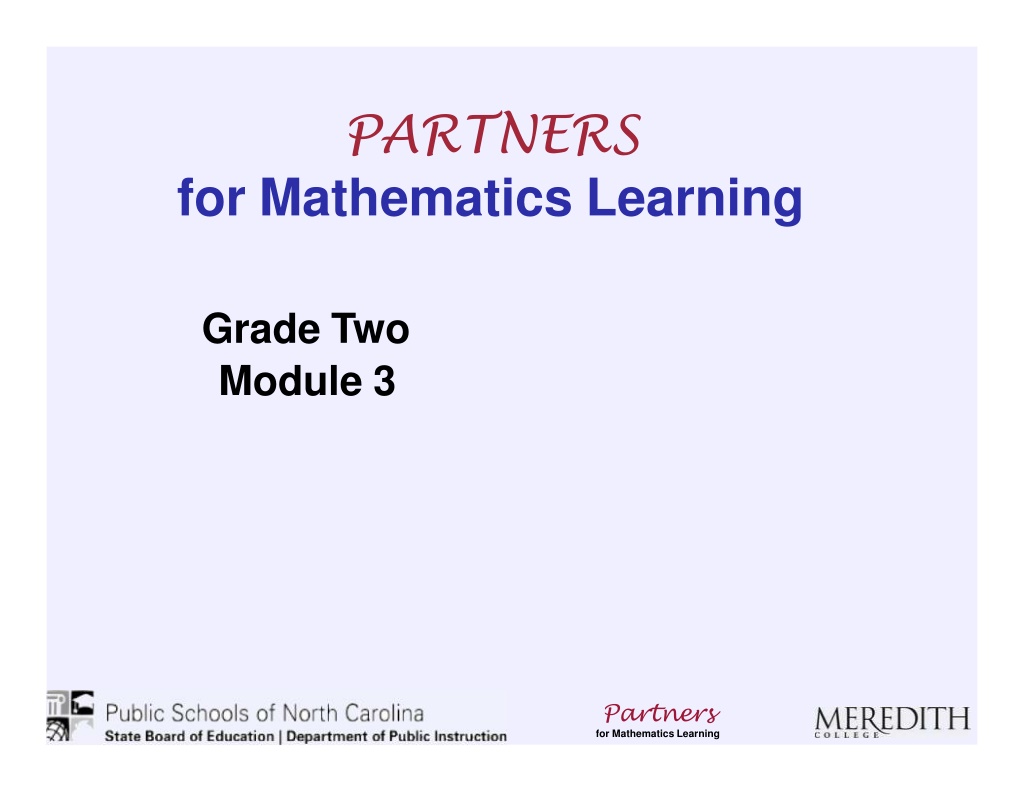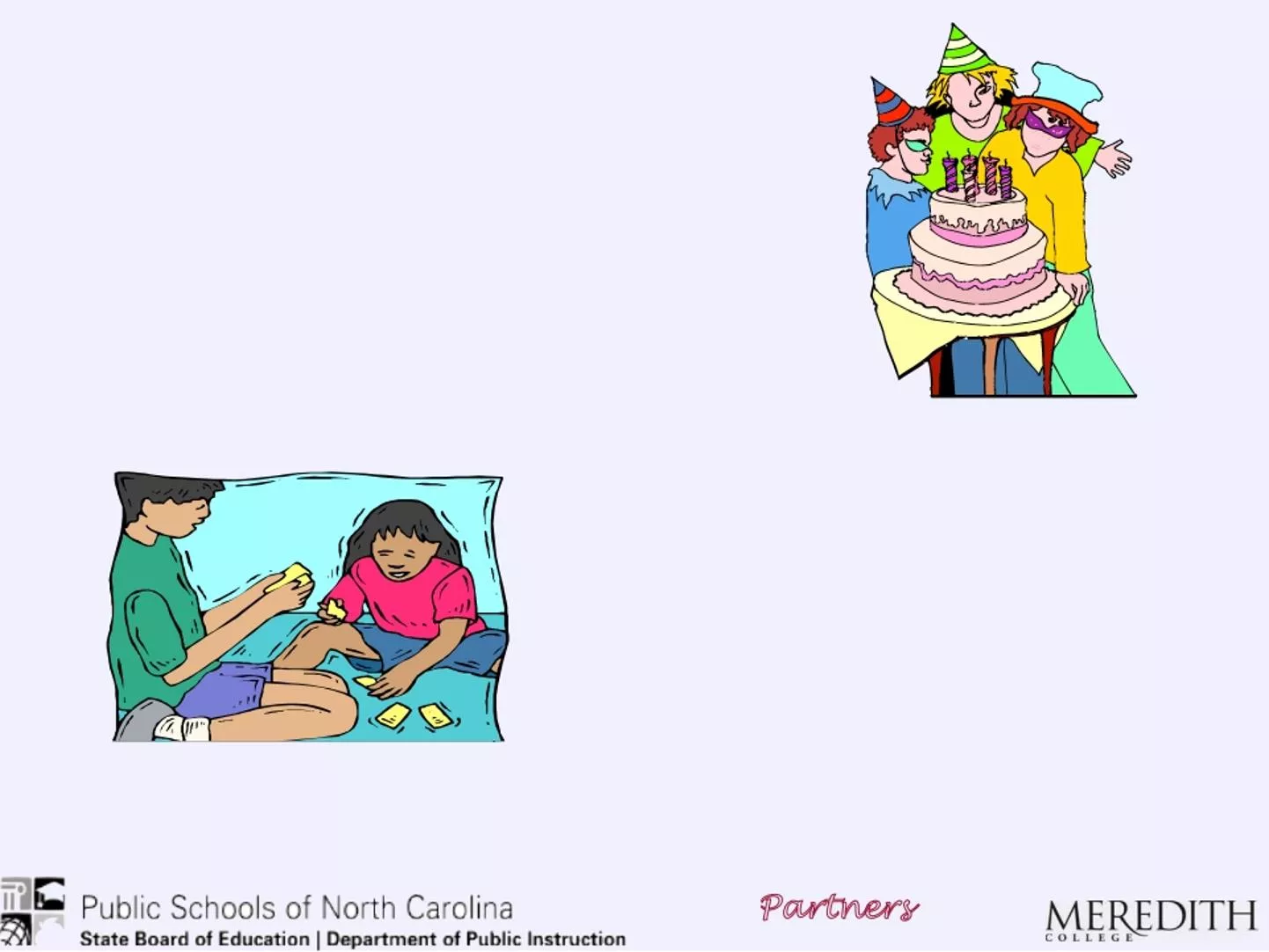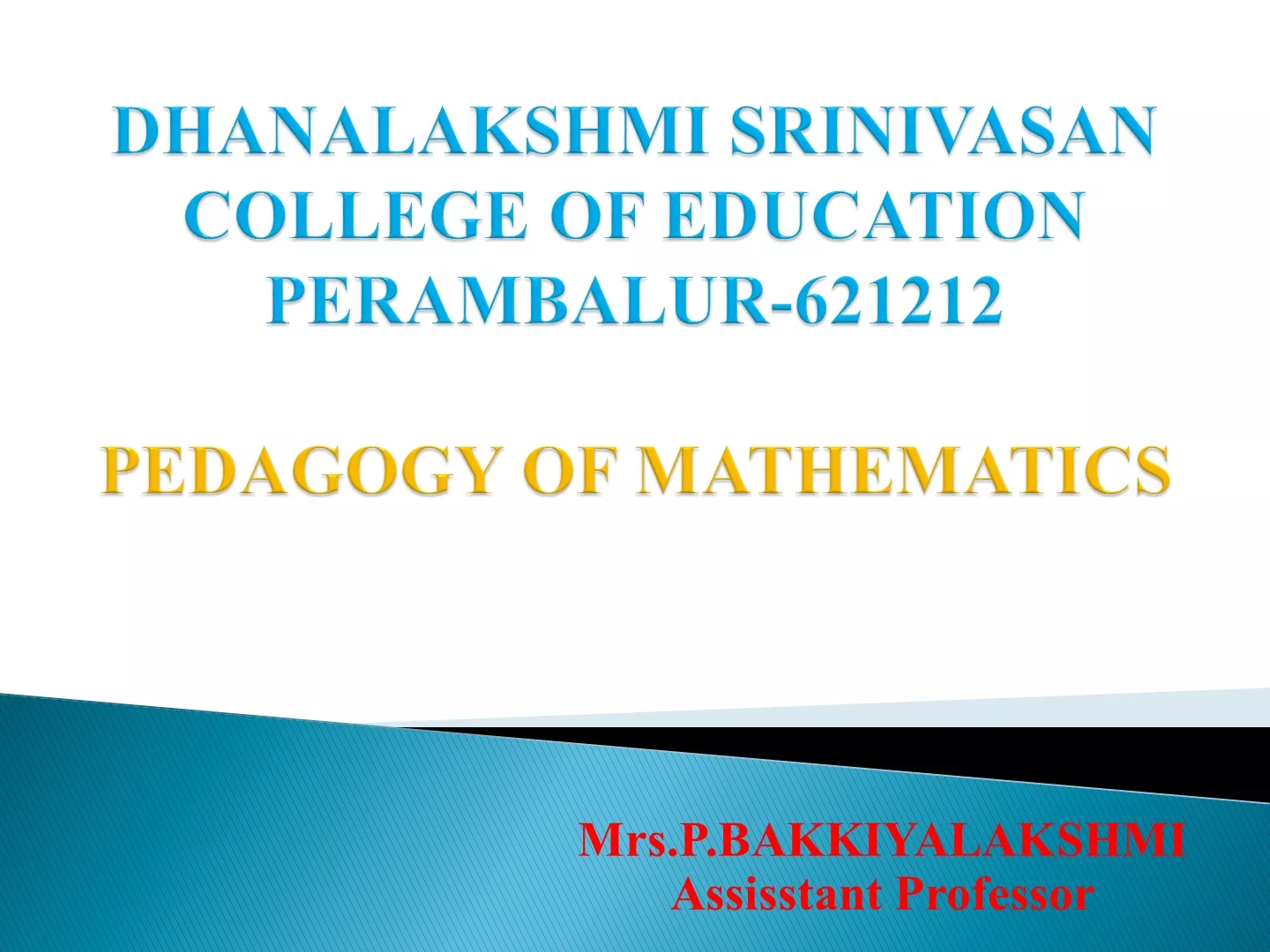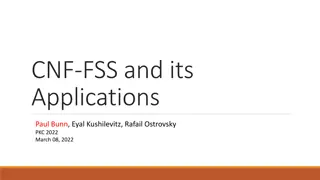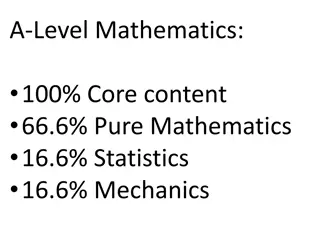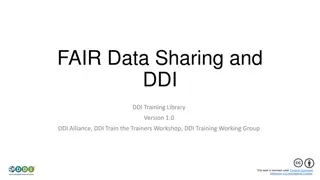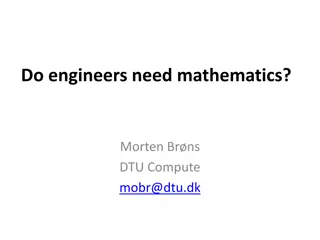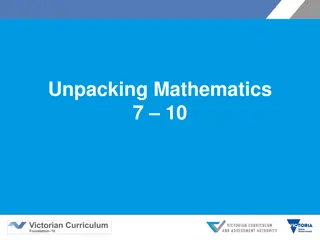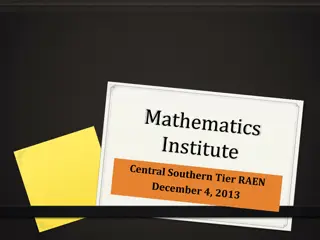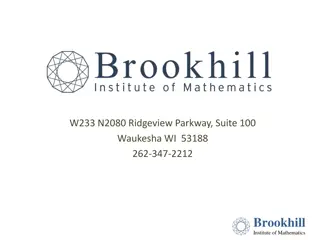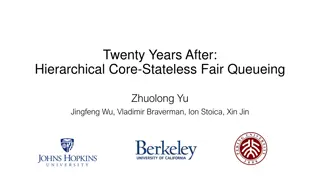Fair Sharing and Equipartitioning in Mathematics Learning
Delve into the concept of equipartitioning and fair sharing in mathematics, focusing on experiences of students in kindergarten through 2nd grade. Understand how to divide objects fairly among different numbers of people, predict size changes in fair shares, and explore division as equipartitioning through engaging activities. Discover the importance of understanding wholes and equal portions in fractions and division, all while fostering critical thinking and problem-solving skills in young learners.
Download Presentation

Please find below an Image/Link to download the presentation.
The content on the website is provided AS IS for your information and personal use only. It may not be sold, licensed, or shared on other websites without obtaining consent from the author.If you encounter any issues during the download, it is possible that the publisher has removed the file from their server.
You are allowed to download the files provided on this website for personal or commercial use, subject to the condition that they are used lawfully. All files are the property of their respective owners.
The content on the website is provided AS IS for your information and personal use only. It may not be sold, licensed, or shared on other websites without obtaining consent from the author.
E N D
Presentation Transcript
PARTNERS forMathematicsLearning GradeTwo Module3 Partners forMathematicsLearning
2 Equipartitioning Equipartitioningmeans SharingFairly Whatexperiences havestudentshad withsharingfairly? Partners forMathematicsLearning
3 WhatHappensinKand1stGrades? Sharecollectionsofobjectsfairlyandreassemble Kindergarten:sharebetween2people 1stgrade:sharebetween2-6people Sharerectanglesandcirclesamongtwoorfour peopleandreassemble 1stgrade Partners forMathematicsLearning
4 WhatHappensin2ndGrade? LookattheEssentialStandards Fairlysharecollectionsandreassemblethem Fairlysharearectangleorcircleamongtwo, four,eight;threeandsixpeopleand reassembleit Nametheshareas 1/nthofthewhole Predictthatthesizeofafairsharedecreases asthenumberofsharesincreases,andvice versa Partners forMathematicsLearning
5 Equipartitioning Partsofawhole Poland France Continuousorareamodels Equalsharesbysub-dividingawhole Partners forMathematicsLearning
6 Equipartitioning Partsofagroup Discreteorsetmodels Dividingintosubsetsofequalsize(equal numbersofelements)
7 Equipartitioning,Division,Fractions Allfocusonequalportions Understandingthe whole isimportant Oftenreferredtoas fairshares Modelsmaylookdifferentdependingon thecontext Partners forMathematicsLearning
8 Equipartitioning,Division,Fractions Howcould2peoplefairlysharethecake? Thegumballs? Howcouldyoudividethecakeandthe gumballsinto2equalparts? Show1/2ofthecakeand1/2ofthe gumballs Partners forMathematicsLearning
9 DivisionasEquipartitioning Getatleast15two-colorcounters Usethemtosolvetheseproblems: Larryand3friendsaresharing12cupcakes. Howmanycupcakeswilleachchildgetifeach getsafairshare? Larry,Mary,DevinandMartezeachhave3 brownies.HowmanybrowniesdidLarry s mombake? Partners forMathematicsLearning
10 StudentThinking Tom,Renee,andSaracollectedsome apples.Eachpersongotfiveapples.What wasthetotalnumberofapplescollected? Whatconceptualunderstandingrelatedto equipartitioningdostudentshave? Howdowestarttobuildunderstandingofthe relationshipsbetweenthewholeandtheequal parts? Partners forMathematicsLearning
11 Relationships:WholesandParts Needstobemadeexplicit Wholewas15apples 5applesrepresented1/3ofthewhole 5representedafairsharefor3people Bringingtogethereachofthethreethirds makesthewhole If5peoplesharedthesamewhole, thefairsharewouldbesmaller Partners forMathematicsLearning
12 ClassroomProblems Writeseveralproblemsfor2ndgradersthat addressdivision asequipartitioning Ideastoinclude Equalsizedgroups Determineinitialsizeofagroupgiven theequalparts Describewhathappenswhencollections aredividedfairlyandwhathappens whenreassembled Partners forMathematicsLearning
13 ConsideringSetModels Thewholeisthetotalsetofobjectsand subsetsofthewholearefractionalparts Numberofobjectsnotsizeisimportant Examples:counters,people,M&Ms, anydiscreteobjects Partners forMathematicsLearning
14 FairShares:Rectangles Foldasquareinhalf Cutyoursquare Howdoyouknoweachhalfisequal?Talk withaneighbor Isyourhalfequivalenttoyourneighbor s? Whatkeyideasdoyouwant2ndgradersto understandinthisactivity? Partners forMathematicsLearning
15 KeyIdeas Eachpartisone-halfofthewholesquare Thetwopartsmakethesquare Whyarethesenothalves(non-examples)? Whymaysomestudentsthinktheyare? Ifwestartedwithdifferentsizesquares, wouldtheone-halvesbeequivalent? Partners forMathematicsLearning
16 OneHalf?HowManyWays? Partners forMathematicsLearning
17 OneHalf?HowManyWays? Partners forMathematicsLearning
18 RectanglesandCircles 2ndgradersshare rectanglesandcircles among2,4,8,3,and6people Whatexperiencesdoweneedtoprovide students? Context Models Partners forMathematicsLearning
19 PeopleFractions Partners forMathematicsLearning
20 Goofy Fractions Partners forMathematicsLearning
22 Context Maria smombaked apanofbrownies HowcanMariasharethebrownieswith3 friendsandherself? Partners forMathematicsLearning
Get to 30 Play the game What mathematics is addressed by the game? Partners forMathematicsLearning
23 ContextualProblems Withapartnerbrainstormproblemsthat matchtheEssentialStandard: Explainthedivisionofrectanglesand circlestoaccommodatedifferentnumbers ofpeople Shareyourideas Partners forMathematicsLearning
24 MakingSenseofFractions Studentsneed: Multiplemodels Experiencewith multiplecontexts Time Language Partners forMathematicsLearning
25 Fractions:ReasonsforDifficulties Contentisnew(proportionalvs.additive reasoning)andnotationisdifferent Conceptual-developmentexperiencesarelimited; symbolsareoftenemphasized Instructionis Tooabstract Tooprocedural Withoutconnections Withlimitedmodels Withoutmeaningfulcontexts
26 FractionResearch Students difficultiesinunderstanding fractionsstemfromlearningfractionsby usingrotememorizationofprocedures withoutaconnectionwithinformalways ofsolvingproblemsinvolvingfractions. SteffeandOlive,2002 Partners forMathematicsLearning
27 In2ndGrade: NoSymbolsforFractions 1 2 Partners forMathematicsLearning
28 Math&Literature Whathappenstoeachchild sshare asthedoorbellrings? Whathappenstoeach child ssharewhen Grandmaarrives? Partners forMathematicsLearning
29 CompensatoryPrinciple Theprinciplestatesthatthebiggerthe unit,thesmallerthenumberofthatunit needed 1/8isfewerthan1/4;1/4isfewcookies than1/2ofthecookies Whatexperiencesmightleadstudentsin developinganunderstandingofthisidea? Partners forMathematicsLearning
30 WhenConceptsAreNot Well-Developed NAEPQuestion: Estimatethesumof12/13and7/8 a.1 b.2 c.19 d.21 Howdidyoudecideyourestimate? Whichanswerdidmost13yearold studentschoose? Partners forMathematicsLearning
31 WhenConceptsAreNot Well-Developed NAEPQuestion Estimatethesumof12/13and7/8 a.1b.2 c.19d.21 Studentslookatfractionsasthoughthey representtwoseparatewholenumbers Thisleadstomisinterpretationandan inabilitytoaccessthereasonablenessof results Partners forMathematicsLearning
32 ChineseProverb TellmeandI'llforget; showmeandImayremember; involvemeandI'll understand. Partners forMathematicsLearning
33 WhatisMeasurement? Acountofhowmanyunitsareneededto fill,cover,ormatchtheattributeofthe objectbeingmeasured Afundamentalmathematicalprocess interwoventhroughoutallstrandsof mathematics Partners forMathematicsLearning
34 WhyMeasurement? Anessentiallinkbetween mathematicsandotherdisciplinessuchas science,art,music,andsocialstudies Itmakesmathematicsrealandtangiblefor studentsgivingthemahandleontheir world Whataretheimplicationsforteaching measurement?
35 Measurement:BigIdeas Anobjectcanbedescribedand categorizedinmultipleways(attributes) Themeasurementofaspecificnumerical attributetellsthenumberofunits Theprocessofmeasurementissimilarfor allattributes,butthemeasurementsystem andtoolvaryaccordingtotheattribute Measurementsareaccuratetotheextent thattheappropriateunit/toolisused properly
36 MeasurementStandards LookattheEssential Standardsfor Measurement LookattheClarifying Objectives Partners forMathematicsLearning
37 Attributes Whataretheattributesofthepresent? Whichofthesearemeasurable? Partners forMathematicsLearning
38 ProcessofMeasurement Determinetheattribute tobemeasured Chooseanappropriateunit thathasthesameattribute Choosethetool Determinehowmanyofthatunitisneeded byfilling,covering,ormatchingtheobject Partners forMathematicsLearning
39 ACloakforaDreamer Coveringspacewith nonstandardunits leavingnogaps oroverlaps Partners forMathematicsLearning
40 MeasuringaSquare Usethepatternblockstocoverthesquare Onlyuseonetypeofpatternblock Partners forMathematicsLearning
41 ComputerActivities www.arcytech.org/java/patterns/patterns_j.shtml Partners forMathematicsLearning
42 MeasurementComponents Conservation Transitivity Partitioning UnitIteration CompensatoryPrinciple Partners forMathematicsLearning
43 ComponentsofMeasurement Conservation:anobjectmaintainsthe samesizeifitisrearranged,transformed, ordividedinvariousways Partners forMathematicsLearning
44 ConservationExamples Studentsexploreconservation Takeaclayball,cutitinhalf.Thenrollone halfintoaballandotherintoasnake.Dothey havethesamemass? Pourthesameamountofliquidfromone containertoanother.Howtallistheliquidin thecontainer?Doesthe amountstaythesame?
45 ComponentsofMeasurement Transitivity:twoobjectscanbecompared intermsofameasurableattributeusinga thirdobject IfA=BandB=C,thenA=C IfA<BandB<C,thenA<C IfA>BandB>C,thenA>C
46 Partitioning Largerunitscanbesubdividedinto equivalentunits mentallysubdividing Chooseaplaceintheroom(table,wall) Mentallydivideitinhalf Chooseaunitofmeasure(marker,handspan) Determinethemeasurementanddoubleit Partners forMathematicsLearning
47 ComponentsofMeasurement Units:theattributebeingmeasured dictatesthetypeofunitused;theunitmust havethesameattributeastheattributeto bemeasured Partners forMathematicsLearning
48 ComponentsofMeasurement Unititeration:unitsmustberepeatedin ordertodeterminethemeasure Partners forMathematicsLearning
49 IterationExperiences Whatquestionsmight youasktoencourage thesestudentstofocus ontheplacementof units? Howcanyouprovideopportunitiesfor studentstouseiteration? Partners forMathematicsLearning
50 CompensatoryPrinciple Thecompensatoryprinciplestatesthat thebiggertheunit,thesmallerthenumber ofthatunitisneeded Turntoyourpartnerandgiveanexample ofwhatthismeans Whathappenswhentheunitusedto measureissmaller?Doyouneedmoreor fewerunits? Partners forMathematicsLearning
